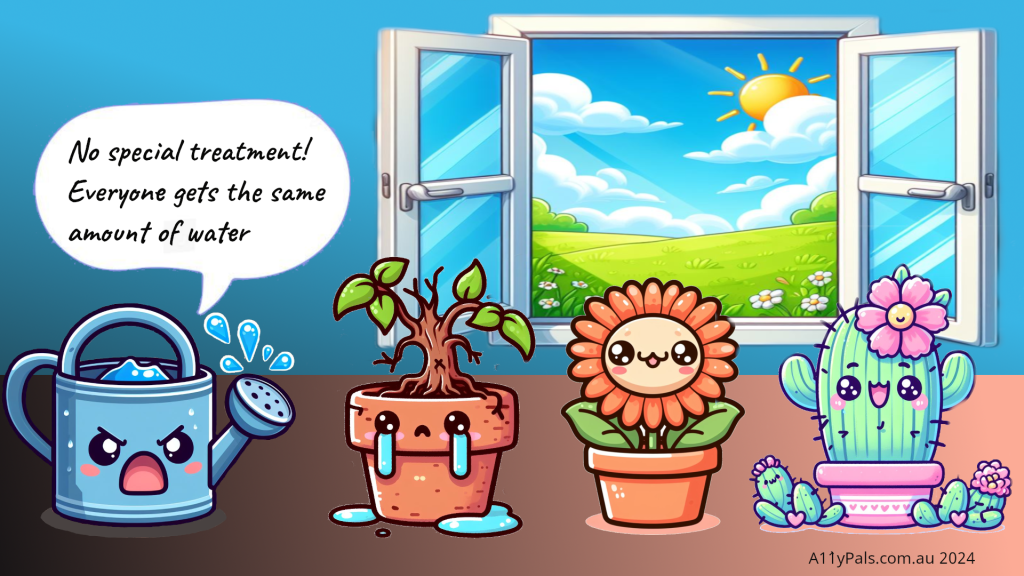Work place adjustments are not special treatment, they simply ensure people’s needs are met and allow them to perform at their best. In this article we will discuss how to handle the sensitive topic of workplace adjustments. We will also discuss how managers can respond when a team member views another team members adjustment as “special treatment.”

What are Workplace Adjustments
A workplace adjustment is a change to a work process, practice, system, setting or policy to enable a person to perform their job more easily and reduce barriers to their participation within the workplace.
Workplace adjustment can be used for many reasons not just for people with disabilities. People with caring responsibilities, English as a second language, living in remote locations and aiding study commitments are just a few other reasons for workplace adjustments.
Why are Workplace Adjustments Necessary
I’m sure most people by now have seen the Equality Vs Equity Vs Ideal/Justice images before. If you don’t know what I am talking about this Google Search will help you. Personally I prefer different analogies so mine is around gardening.
Equality
Like the image of the plants, everyone gets the same amount of resources and they are expected to produce the same results. This is equality. In this analogy all plants get the same amount of water and are expected to bloom and reproduce. We don’t however factor in that some are starting from different points.
- A cactus needs little water and can survive in most soil types. It will grow and reproduce quickly.
- Flowering plants need more nitrogen in their soil and in full sun may affect their chances of reproducing after flowering. The seeds may fall not to soil but hard ground or a table.
- A tree is highly at risk in sapling phase. It can become rootbound if it grows too quickly. If not repotted, regardless of how much water they get, they will not have enough nutrients from the soil and will fail.
Soil type, species, size of pots, and temperatures are just some of the other factors which can affect how much water a plant really needs. Providing the same amount of in demand resources in this case water, can be considered equality. While the resource is equal, the outcome is not.
Equity
Equity is about acknowledging the facts that everyone does not start at the same point. Even plants of the same kind will grow and develop differently in subtle environmental changes e.g. sandy soil versus clay.
Simple species classification tells us that Cactuses need less water than a flowering annual, trees need different amounts based on their lifecycle.
For equity we adjust the resources based on need. Clearly in the image above the tree in the first pot is struggling and it just leaked out the last of it’s water in tears. Giving the tree more water is likely going to help it grow. We adjust to what each needs.
Ideal
The ideal is simply that we remove all barriers which we need to alleviate in the first place. But until someone invents perfect climate, soil and moisture control, we need to start with equity.
What To Do When a Team Member Requests and Adjustment

- Start a dialogue. Understand the problem that the person is facing.
- Be open minded.
- Consider “What if we did…” rather than “But we don’t…”
- assuming something can’t be done because it has not been done before is limiting. Covid proved that many things not done widescale before such as flexible working arrangements can be done.
- Consider confidentiality. It may have taken courage to ask for an workplace adjustment. Advising the team of a change is OK, discussing someone’s full medical history to justify a workplace adjustment is not.
What To Do When a Team Member Questions Another’s Workplace Adjustment
Unfortunately one of the problems of being humans is selfishness. Sometimes you will run into someone who interprets another’s gain as their loss (even if it’s something they never needed or wanted). They can get upset and see it as special treatment. If you are not proactive when offering a workplace adjustment you may receive comments like:
- “Why do they get special treatment?”
- “It’s not fair”
- “I don’t get to…”
- “Well I have needs too”
- “No one helped me when I had problems”

How should we be proactive when creating workplace adjustments to ensure we balance everyone’s feelings and needs?
Reframing with Empathy
It hurts if you feel you are not receiving the same treatment of others. When a team member raises their concerns you should address with empathy. Remind your team members a workplace adjustment provide what is needed for someone to perform at their best. A workplace adjustment’s purpose is not to “take resources away” from others. Remind them that they too can raise a request for their needs. Affirm that you would be happy to discuss, as well as maintain confidentiality, into the reason for the workplace adjustments. The same as you do for all team members.
Redirection to Policy
Redirect disgruntled employees to workplace adjustment policies as well as your workplace bullying and harassments policy. Remind them that the reason for a workplace adjustment may be private, and is not a reason to discriminate (directly or indirectly), victimize or bully another team member.
Explain the process for reviewing workplace adjustments including how workplace adjustments are periodically reviewed for it’s effectiveness, ongoing need and that it is not causing undue hardship on the workplace.
Remind of Rights (for all parties)
Periodically remind teams of their rights for workplace adjustments and checking-in to see if the current environment is working for everyone. Ensure this is a standard part of full team meetings and individual 1:1s. This should be done regardless of any workplace adjustment being in place.
Encourage your team to understand the workplace adjustment process so that it is less scary to people. Often when people who are having difficulties simply “try to make things work” even if they need a little extra support, because of concern over how difficult requesting a a workplace adjustment may be.
Reviewing Needs (of all parties)
 |
I need help some help. Without more water I can’t thrive. |
 | I need help, I can’t carry more water. |

|
I don’t really need as much water as the others, but I could use a bigger pot. This pot is getting a little uncomfortable. |
 |
I’m pretty good right now, but at some point I will stop blooming. Then I will need someone to remove my spent flowers. |
It is important to address team dynamics. Sometimes there may be situations where one person’s adjustment may have a negative impact on another person. When considering workplace adjustments you should as a team have an open mind. It is just as important to consider and ask
- “If we didn’t have limitations, what would ‘ideal’ look like?”
- “How can we…?”
- “Why we should…”
- “How can we resolve the underlying problems as a team?”
- “What impacts can this have on the team?”
Additionally just because one person has raised their need for a workplace adjustment does not mean there are not other people in the team who are also struggling. Think of a workplace adjustment request as a great time to check-in with other team members. Even proactively discuss options on how to alleviate problems teammates and the team may be having, crowd sourcing ideas for alleviating problems is a great way to engaged team members. Engaging the team to solve problems may additionally highlight other innovations which otherwise may not have been considered.
What Happens If You Get It Wrong?
Whether you ignore people’s needs or fail to regularly check-in with your team you are going to run into issues with both individuals and the whole team. Some of these issues can be very serious and not just affect morale but also legal obligations. Ignoring needs can lead to:
- Discrimination (and potential breach of laws)
- Isolation and feelings of disconnection
- Resentments (“Us” and “Them”, mentalities)
- An unsafe work environment (both physical and psychological)
- Higher turn over rates of staff
- Lower productivity
When to Start Your Next Discussion
Manager
Don’t wait for a workplace adjustment request. Be proactive. Remind people regularly of their rights. Check in to see how your team are. If you are not already having team meetings and 1:1 meetings with your team members, now is a good time to start.
Individuals
It can be scary asking for support. If you are not comfortable going to your manager or team without a plan, it can be a great idea to chat with one of your peers or a mentor first.
Perhaps at your next 1:1 ask your manager about workplace adjustment policies and seek clarity on what you should do if you feel you need some help at work now or may need help in future.
Remember if a process, practice or procedure is causing you trouble, you may find other team members are having similar issues and if you speak up it might make it easier for others to speak up too.
Summary
Remember the 4 “R’s”
- Reviewing needs – of both individual and team
- Reframing – paint a clear picture that workplace adjustments benefit whole teams and does not take resources away from one team member to give to another.
- Redirection to policy – make sure people know where to go to review your policies
- Remind of Rights – remind that everyone has the ability to request and adjustments and that all adjustments will be reviewed and approved or denied within a timeframe specified in your company’s policies. Advise that the reason behind an adjustments may not be disclosed to everyone and that all requests are treated confidentially.
